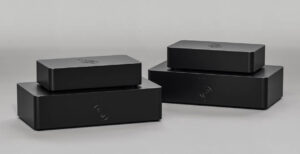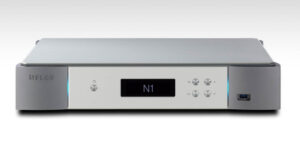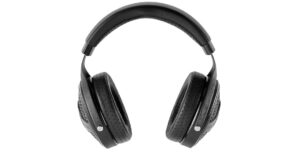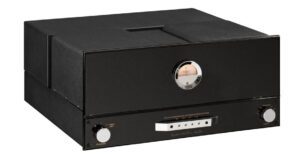
Comparatively little known outside its native Bulgaria, APL Hi-Fi, Ltd has actually been around since 1988. The company’s chief designer, Alex Peychev, exploits his decades working in professional and broadcast electronics to create a comprehensive line of audio equipment, spanning digital front-ends, phono stages, amplifiers, and even loudspeakers. APL is also no stranger to either hollow or solid-state technology, with designs that include both valve and transistor devices.

We focused on APL’s digital side and the middle of three DACs made by the company: the DSD-S from the company’s ‘Illumi-Fi’ series. This is a more full-function converter than the USB only, 24/192 DAC-X (currently the only product in API’s ‘Hi-Fi’ range) but lacking the tube output stage and the considerably higher price of the ‘Illumi-Fi Reference’ DSD-M digital converter. I’ve not had chance to audition either of the other DACs in the APL range, but the smart money from those in the know is thet the DSD-S is in something of a sweet spot in the line.
This is a carriage-built design, truly boutique in outlook and handmade to order: an ambitious concept when it comes to making a DSD-based DAC, because that usually requires a lot of engineering teams. But that’s not the case here; it really is bespoke. Open the player up and you are met with six separate APL-designed PCBs: power supply filtration, power distribution, input block, digital conversion, output block, and display. The digital input block sports the popular XMOS transceiver for USB and some useful crystal clocking circuitry, but the real story on the inside is the use of some classic components inside both the DAC and output stages. The DAC itself is made up of a quartet of Cirrus Logic DSD-chummy chips that are no longer available.
This DAC is controlled by custom code written into an FPGA. Similarly, in the output stage board, the main output MOSFETs are the highly desirable – and long discontinued – Toshiba designs. These are some of the best sounding output devices ever made, and are still used today by companies like Constellation Audio because nothing made this millennia comes close. The board also sports two classic Lundahl coupling transformers, and the closer you get to the output stage, the more the PCBs move from surface mount devices to classic hand-soldered resistors, capacitors, and transistors. It’s not all pre-millennial technology though; alongside that USB input, there are special relay-controlled DC servos in the actual amp stage. Nevertheless, this is a DAC built by someone who knows his way around quality components.
Principally, however, APL is a company that has a terrific amount of skill in analogue audio design, while also knowing what goes into making a good DAC. This seems like a better way of making a good bespoke converter than the digital engineer who thinks analogue output stages are ‘easy’ and then botches the bit of the electronics that connects their masterwork to the outside world. However, the key element is being able to get both parts right. Peychev’s skills lie in building and modifying the output stages and key digital modules in classic CD and SACD players, as well as a great deal of work on analogue circuit design in all kinds of audio components. This is the true art of the bespoke maker in audio – not making a more expensive version of a standard product that can be purchased for less from mass-market rivals, but producing a pure artisan product that by its very nature is the produce of years of audio hot-rodding. The downside to this is sometimes the result is only pleasing to the designer and his immediate family, while the rest of the world beats a path to any other door. However, when they get it right – as is the case in Peychev’s APL products, based on this model – it can sound extremely good, and completely unlike anything else made in modern audio.
The audio press loves a good analogy, but will happily settle for a mediocre one. We are all keen to compare audio to bikes, cars, cameras, watches… basically any middle-aged adult-male plaything that doesn’t land the writer in jail or the divorce court. I am not one to break with tradition, but at least I can add a bit of a twist. So if I can liken the audio world to a 1980s Coming of Age movie – and I think I can – then many audio companies are like the decorative, yet vacuous cheerleader the protagonist spends the first reel lusting after at a distance. A few are the bookish, more intellectual and interesting love interest that is completely forgotten about until their makeover in the final reel. And that sums up the APL DSD-S: it’s Ally Sheedy at the end of The Breakfast Club.
Where I’m going with this rapidly self-destructing analogy is there are many products that deliver an immediate, yet ultimately unrewarding experience, but the ones that take time to divulge their inner beauty are the ones you want to spend the longest time listening to. And that perfectly describes the APL DSD-S. This is not a race through your music collection, this is a smooth, satisfying ramble around your musical tastes, and a ramble that sustains as well.
Sophistication seems to be a word that is fast falling out of fashion in the audio world. Instead, products look great and sound shiny, bright, and forward. The APL DSD-S resolutely refuses to play that game, instead making a sound that is as inviting as it is insightful and detailed. Moreover, rather than opting for the big and impressive soundstage, this DAC produces a tighter, more natural-sounding soundstage that sits in the room between the loudspeakers. This invites you to explore the elements of that soundstage, rather than let tingit wash over you. With big soundstages (Mahler’s Eighth Symphony, played by Solti and the Chicago SO on Decca), the soundstage is still large, but not exaggerated or over-extended. It’s just ‘right’ sounding.
Removing the bright, forward sound intrinsic to many digital devices today does an odd thing: it makes the music sound more detailed. There is a mistaken idea that bright sounding equipment is supposed to appear ‘detailed’, and the APL DAC exposes this as nonsense. It is extraordinarily detailed. I played Donny Hathaway’s cover of ‘Misty’ on his 1972 album Everything is Everything [Atco] – not necessarily one of my reviewing test discs, but a fine album featuring a brilliant, fractured man with the voice of an angel. I know this album backwards, and yet I was hearing subtle new sounds within the recording that can be heard on a good pressing of the record, but typically aren’t there on the digital file. The APL cut through all to make these spring to life. Brilliant!
All this being said, I don’t think the DAC is completely tonally neutral, as there is a slight bloom in the mid-bass. It’s hard to detect; it’s the sound of a tenor, only slightly more full and expressive. That’s not needed with someone like Domingo singing arias on Opern-Gala [DG], but fortunately the APL stays just the right side of ‘warming the sound up’ to make this seem over-rich. Think instead, ‘consistently musically delightful’, which is what the APL is (and does).

The APL DSD-S isn’t for everyone, so deep runs the clarion call of forward sounding electronics and a bright sound. However, if you are seeking the mature and sophisticated digital choice, rather than the immediate gratification of some players, I urge you to try the APL DSD-S. In fact, try it for a few days and then switch back. If your digital files now sound ‘thin’ and ‘forward’, the DSD-S has you in its sights. Recommended if you are willing to nurture your musical experience!
TECHNICAL SPECIFICATIONS
- Type: Digital to analogue converter
- Digital Inputs: Two S/PDIF Coaxial digital inputs with WBT RCA connectors. One Toslink S/PDIF connection. AES/EBU professional standard balanced digital input. USB B. Proprietary DTR input for APL digital transport.
- Analogue Outputs: 2× single-ended WBT RCA sockets
- Output impedance: approx. 15Ω
- Digital formats supported: (S/PDIF) PCM up to 24-bit, 192kHz. (USB and DTR) PCM up to 32-bit, 384kHz, DSD64 and DSD128. All PCM formats upsampled to DSD64 or DSD128, user selectable
- Attenuation: Analogue, in 0.5dB steps
- Frequency response: not specified
- THD+N: not specified
- Signal to noise ratio: not specified
- Dimensions (W×D×H): 45×28×11cm
- Weight: 8.5kg
- Price: £6,500
Manufactured by: APL Hi-Fi, Ltd
URL: www.aplhifi.com
Distributed in the UK by: Epicurean Audio
Tel: +44(0)780 556 7630
Tags: FEATURED
By Alan Sircom
More articles from this authorRead Next From Review
See all
Reiki Audio SuperSwitch Master Pro + Servant Pro
- Mar 27, 2024

Melco Audio N1-S38 music server
- Mar 27, 2024

Focal Utopia 2022 headphones
- Mar 27, 2024











